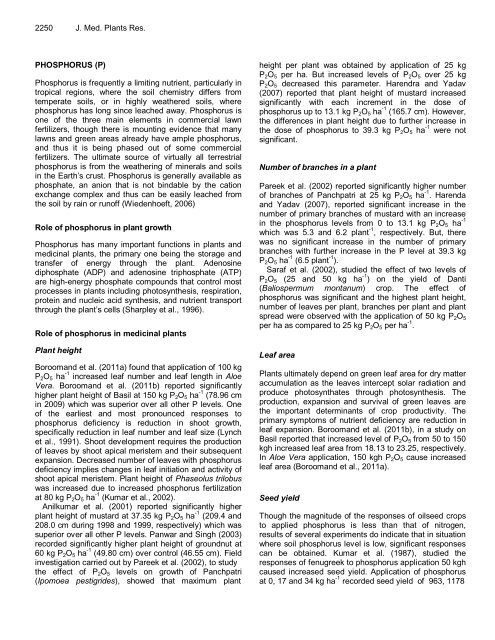Download Complete Issue - Academic Journals
Download Complete Issue - Academic Journals
Download Complete Issue - Academic Journals
You also want an ePaper? Increase the reach of your titles
YUMPU automatically turns print PDFs into web optimized ePapers that Google loves.
2250 J. Med. Plants Res.<br />
PHOSPHORUS (P)<br />
Phosphorus is frequently a limiting nutrient, particularly in<br />
tropical regions, where the soil chemistry differs from<br />
temperate soils, or in highly weathered soils, where<br />
phosphorus has long since leached away. Phosphorus is<br />
one of the three main elements in commercial lawn<br />
fertilizers, though there is mounting evidence that many<br />
lawns and green areas already have ample phosphorus,<br />
and thus it is being phased out of some commercial<br />
fertilizers. The ultimate source of virtually all terrestrial<br />
phosphorus is from the weathering of minerals and soils<br />
in the Earth’s crust. Phosphorus is generally available as<br />
phosphate, an anion that is not bindable by the cation<br />
exchange complex and thus can be easily leached from<br />
the soil by rain or runoff (Wiedenhoeft, 2006)<br />
Role of phosphorus in plant growth<br />
Phosphorus has many important functions in plants and<br />
medicinal plants, the primary one being the storage and<br />
transfer of energy through the plant. Adenosine<br />
diphosphate (ADP) and adenosine triphosphate (ATP)<br />
are high-energy phosphate compounds that control most<br />
processes in plants including photosynthesis, respiration,<br />
protein and nucleic acid synthesis, and nutrient transport<br />
through the plant’s cells (Sharpley et al., 1996).<br />
Role of phosphorus in medicinal plants<br />
Plant height<br />
Boroomand et al. (2011a) found that application of 100 kg<br />
P2O5 ha -1 increased leaf number and leaf length in Aloe<br />
Vera. Boroomand et al. (2011b) reported significantly<br />
higher plant height of Basil at 150 kg P2O5 ha -1 (78.96 cm<br />
in 2009) which was superior over all other P levels. One<br />
of the earliest and most pronounced responses to<br />
phosphorus deficiency is reduction in shoot growth,<br />
specifically reduction in leaf number and leaf size (Lynch<br />
et al., 1991). Shoot development requires the production<br />
of leaves by shoot apical meristem and their subsequent<br />
expansion. Decreased number of leaves with phosphorus<br />
deficiency implies changes in leaf initiation and activity of<br />
shoot apical meristem. Plant height of Phaseolus trilobus<br />
was increased due to increased phosphorus fertilization<br />
at 80 kg P2O5 ha -1 (Kumar et al., 2002).<br />
Anilkumar et al. (2001) reported significantly higher<br />
plant height of mustard at 37.35 kg P2O5 ha -1 (209.4 and<br />
208.0 cm during 1998 and 1999, respectively) which was<br />
superior over all other P levels. Panwar and Singh (2003)<br />
recorded significantly higher plant height of groundnut at<br />
60 kg P2O5 ha -1 (49.80 cm) over control (46.55 cm). Field<br />
investigation carried out by Pareek et al. (2002), to study<br />
the effect of P2O5 levels on growth of Panchpatri<br />
(Ipomoea pestigrides), showed that maximum plant<br />
height per plant was obtained by application of 25 kg<br />
P2O5 per ha. But increased levels of P2O5 over 25 kg<br />
P2O5 decreased this parameter. Harendra and Yadav<br />
(2007) reported that plant height of mustard increased<br />
significantly with each increment in the dose of<br />
phosphorus up to 13.1 kg P2O5 ha -1 (165.7 cm). However,<br />
the differences in plant height due to further increase in<br />
the dose of phosphorus to 39.3 kg P2O5 ha -1 were not<br />
significant.<br />
Number of branches in a plant<br />
Pareek et al. (2002) reported significantly higher number<br />
of branches of Panchpatri at 25 kg P2O5 ha -1 . Harenda<br />
and Yadav (2007), reported significant increase in the<br />
number of primary branches of mustard with an increase<br />
in the phosphorus levels from 0 to 13.1 kg P2O5 ha -1<br />
which was 5.3 and 6.2 plant -1 , respectively. But, there<br />
was no significant increase in the number of primary<br />
branches with further increase in the P level at 39.3 kg<br />
P2O5 ha -1 (6.5 plant -1 ).<br />
Saraf et al. (2002), studied the effect of two levels of<br />
P2O5 (25 and 50 kg ha -1 ) on the yield of Danti<br />
(Baliospermum montanum) crop. The effect of<br />
phosphorus was significant and the highest plant height,<br />
number of leaves per plant, branches per plant and plant<br />
spread were observed with the application of 50 kg P2O5<br />
per ha as compared to 25 kg P2O5 per ha -1 .<br />
Leaf area<br />
Plants ultimately depend on green leaf area for dry matter<br />
accumulation as the leaves intercept solar radiation and<br />
produce photosynthates through photosynthesis. The<br />
production, expansion and survival of green leaves are<br />
the important determinants of crop productivity. The<br />
primary symptoms of nutrient deficiency are reduction in<br />
leaf expansion. Boroomand et al. (2011b), in a study on<br />
Basil reported that increased level of P2O5 from 50 to 150<br />
kgh increased leaf area from 18.13 to 23.25, respectively.<br />
In Aloe Vera application, 150 kgh P2O5 cause increased<br />
leaf area (Boroomand et al., 2011a).<br />
Seed yield<br />
Though the magnitude of the responses of oilseed crops<br />
to applied phosphorus is less than that of nitrogen,<br />
results of several experiments do indicate that in situation<br />
where soil phosphorus level is low, significant responses<br />
can be obtained. Kumar et al. (1987), studied the<br />
responses of fenugreek to phosphorus application 50 kgh<br />
caused increased seed yield. Application of phosphorus<br />
at 0, 17 and 34 kg ha -1 recorded seed yield of 963, 1178

















